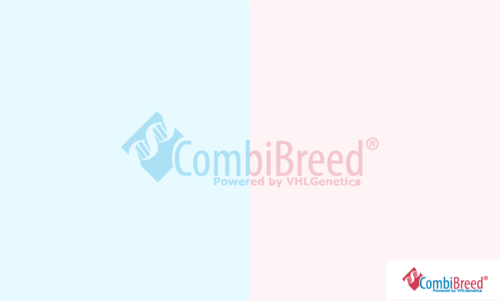S-Locus (Piebald, White Spotting)
Piebald is a coat pattern characterized by the presence of white spots or splotches on the fur. This pattern is caused by a mutation in the gene encoding -associated transcription factor (MITF), commonly referred to as the Spotting Locus (S-Locus). Piebald is a form of white spotting, other variants of white spotting exist but research is still ongoing and they are currently not available through CombiBreed. Other known white spotting variants are Irish Spotted and Extreme White. Solid dogs do not carry a MITF-mutation. Piebald is also known as: parti, particoloured or random white.
Piebald White Spotting is characterized by unsymmetrical white patches on the coat. The pattern can vary between small spots to an almost complete white colour. In heterozygotes, the coat pattern is sometimes similar as the Irish Spotted dogs. They are also known as pseudo-Irish. However, Piebald has a wide variety of expression patterns.
There is a higher risk of deafness in dogs that carry a Piebald mutation. The exact inheritance of this trait is unknown, what makes it difficult to avoid risky combinations. These defects have been studied in mice and research is still ongoing. The general guideline that the more white, the more frequent a defect occurs probably also applies here.
Inheritance
The Piebald mutation is incomplete dominant in some breeds, meaning that dogs carrying at least one copy of the mutant allele will exhibit some degree of white spotting on their original coat colour and pattern. Phenotypes of heterozygotic animals can differ from homozygotic animals. Sometimes homozygote dogs express more wite then heterozygotes. Sometime homozygotes are completely white. In other breeds the mutation is recessive and only shows when the dog has two copies of the Piebald mutation. The extend of white spotting can vary among individuals and breeds. Much is still unknown of about the inheritance of white spotting. The Piebald phenotype could be influenced by additional MITF-variants or other mutations on different genes. It is hypothesized that modifier genes, which can either increase or decrease the extent of white spotting, also play a role. These variants may be breed-specific.
| Genotype S-Locus | Coat Colour * | Interpretation |
|---|---|---|
| N/N | No piebald, normal coat colour | The basic colour is not modified. It can only pass on allele N to its offspring. |
| N/S | Piebald (dominant) OR normal colour (recessive) | Dog has one copy of the S allele. If mutation is dominant in the breed, the dog shows piebald spotting. The amount of white depends on the breed and possible modifying genes. In breeds where the mutation is recessive, the dog is a carrier of Piebald but doesn’t show it. In both cases, it passes on the S allele to 50% of its offspring and the N allele for the other 50%. |
| S/S | Piebald | The basic colour is modified by the S alleles, resulting in a piebald coat. The amount of white depends on the breed and possible modifying genes. The dog will pass on the S allele to 100% of its offspring. |
Breed specific examples
In breeds like the Collie, Great Dane, Italian Greyhound, Shetland Sheepdog, Boxer, and Bull Terrier, the Piebald pattern is influenced by the dosage of the MITF variant. Dogs with one copy of this variant exhibit some white patterning, while those with two copies show more extensive white, often with colour limited to the head and possibly a spot on the body. Specifically, in Boxers and Bull Terriers, dogs with two copies of the MITF variant are entirely white, whereas those with one copy display the mantle/flash pattern.
Additional information
The expression of the piebald allele can be quite different, from small white spots on the limbs or neck to almost a complete white coat. Probably modifying genes determine the amount of white that is expressed. However, these genes are still unknown and therefore the exact inheritance cannot be explained yet. Results are based on the general trend of the known piebald mutation. Individual results can differ. Furthermore, unknown variants of white spotting can explain animals that test negative for piebald but express white spotting in the coat.
Relevant tests
- H326
